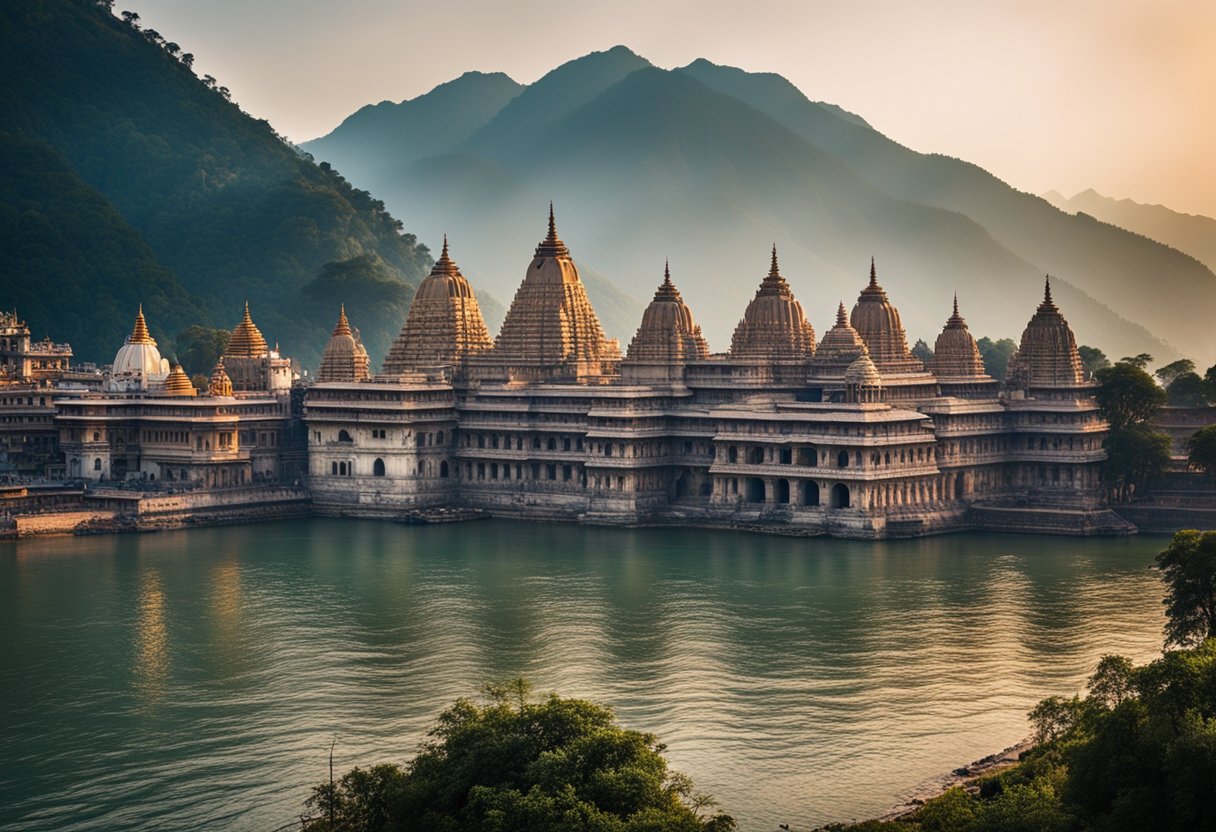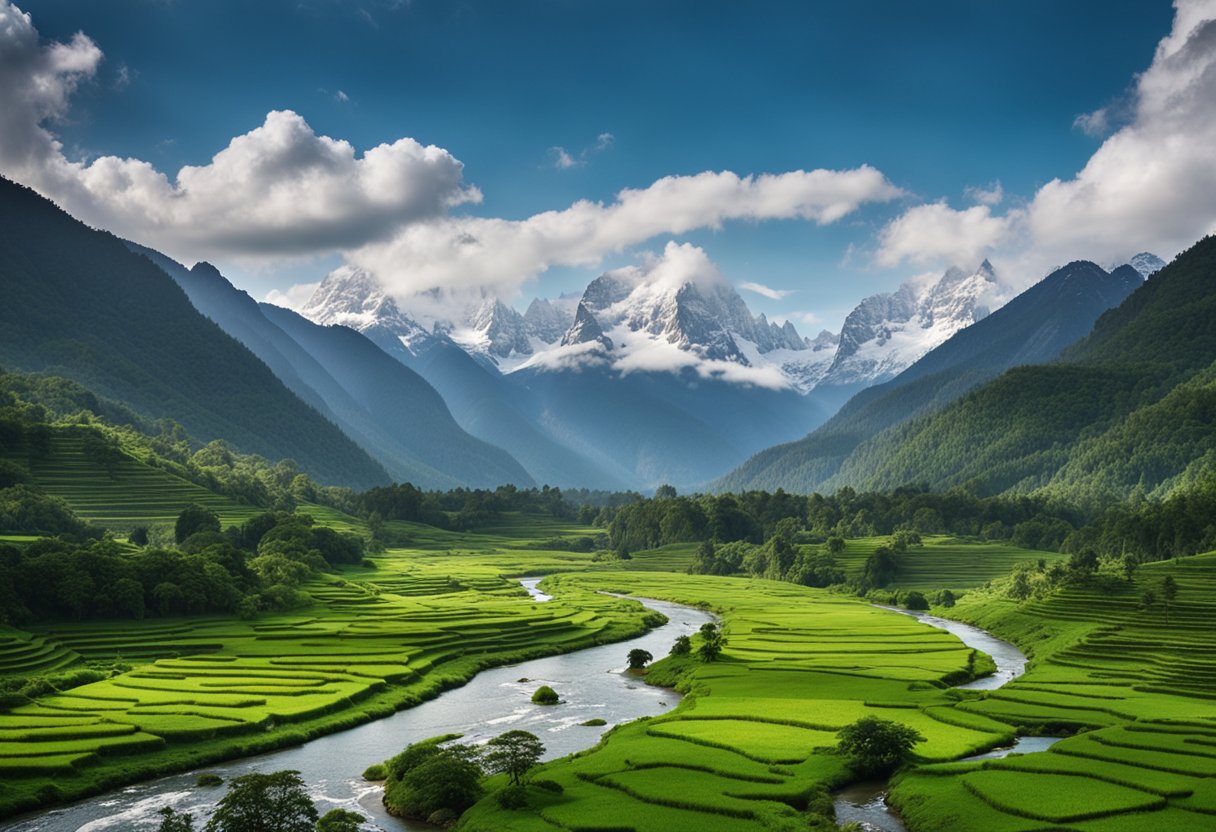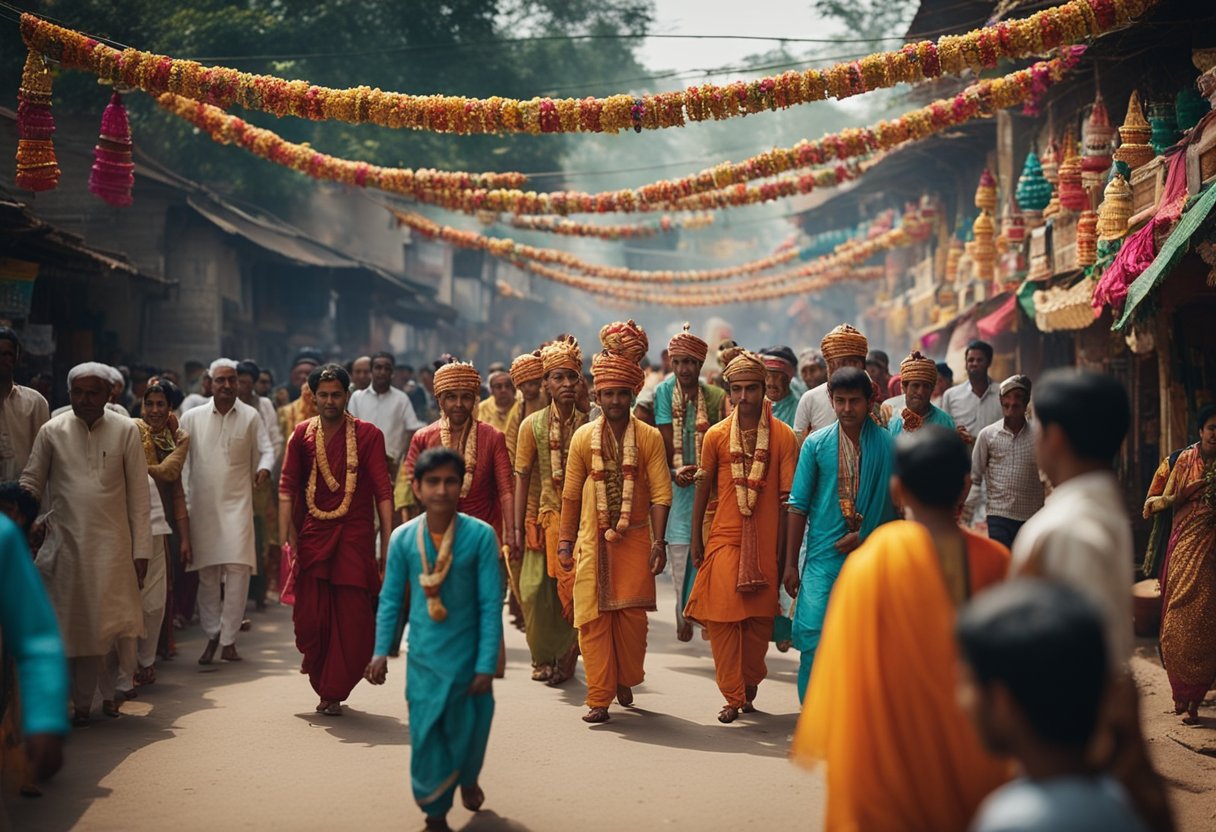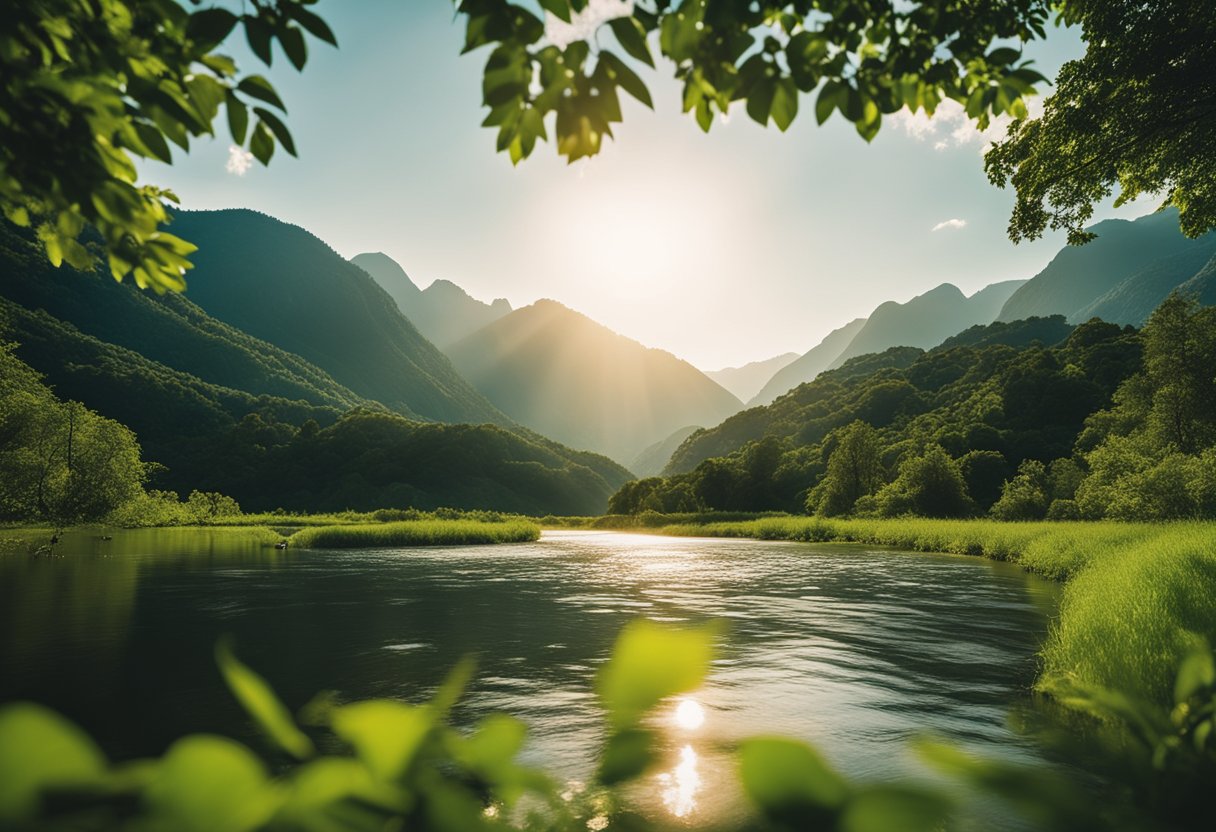The Spiritual Landscapes of India: Sacred Sites from the Ganges to the Himalayas

Updated On: April 13, 2024 by Eman Sameh
The spiritual Landscapes of India have long been celebrated for their profound and majestic landscapes of the Ganges River and the towering Himalayas. The Ganges, or Ganga, is not merely a river but a source of life, spirituality, and tradition for the millions who live along its banks. It encapsulates a world where daily life intertwines with sacred rituals, presenting a vivid tableau of ceremonies that resonate deeply with the reverence of Hinduism. As the river flows from its Himalayan heights, it nurtures a cultural richness that has evolved over millennia, making it a symbol of purity and deliverance.

Ascending from the river banks to the serene peaks of the Himalayas, one encounters the spiritual calm of the mountainous landscapes. These high altitudes play host to the practices of Buddhism and provide the ideal backdrop for seekers of inner peace and enlightenment. The monasteries, yoga retreats, and ashrams scattered across the Himalayan regions of Dharamshala, Ladakh, and Rishikesh offer solace to those yearning for spiritual growth. Here, against the backdrop of nature’s grandeur, pilgrims and travellers find a sense of connection to the divine, affirming the Himalayas’ status as a potent source of both geographical and spiritual awe.
The Spiritual Landscapes of India
Within the vast landscapes of India, we find two geographical wonders that captivate the spirit and embody the majesty of nature: the imposing Himalayas and the glorious Ganges River. These landmarks are not just natural wonders but are also deeply intertwined with the cultural and spiritual fabric of Indian society.
Exploring the Himalayas
The Indian Himalayas present a breathtaking spectacle that stretches across the northern boundary of India. We are drawn to the state of Uttarakhand, home to some of the most astonishing peaks and valleys. Here, the Gangotri Glacier, a vital source of the Ganges River, signifies both natural beauty and spiritual sustenance. The awe-inspiring snow-covered peaks serve as a source of inspiration and adventure for all who witness their grandeur.
Glorious Ganges River
The Ganges River flows from the lofty summits, embarking on its journey from the Bhagirathi River, and traverses across the expansive plains. This river, beyond its tangible presence, is revered and personified as a goddess imbued with purifying qualities. The Ganges is an embodiment of natural beauty, its banks lined with a rich tapestry of life that pulses to the rhythm of the river’s flow. Its waters are not just life-giving; they are also central to numerous religious ceremonies, intersecting with the lives of millions.
Historical and Cultural Tapestry
In the rich mosaic of Indian spirituality, historical and cultural heritage is not just preserved; it’s lived and breathed. Cities and landscapes are deeply steeped in tradition, with every stone telling a tale of faith and philosophy.
Varanasi: The Eternal City
Varanasi, also known as Benaras or Kashi, is a testament to India’s ancient cultural heritage. As one of the oldest living cities in the world, it exudes a timeless charm through its temples and ghats. The city’s spiritual aura is palpable, particularly at the Ganges river, where the ghats present a theatrical tableau of life and its rituals. Pilgrims perform ablutions in the sacred waters amid the backdrop of centuries-old temples that rise majestically along the river’s banks.
The Spiritual Heritage of Uttarakhand
In Uttarakhand, we are transported to a realm where legends and natural beauty intertwine. The region is dotted with ancient temples and is pivotal to many stories from Hindu mythology. Among its many sacred sites, Gangotri and Yamunotri are sources of the Ganges and Yamuna rivers, respectively, reflecting the physical and spiritual sustenance they provide. The importance of this area is underlined by the Char Dham pilgrimage, which is held in high esteem by believers who visit the shrines nestled within the laps of the Himalayas.
Buddhist Monasteries and Teachings
Exploring further into the Himalayas brings us to the tranquil monasteries where the ambience is steeped in Buddhist teachings. The influence of Tibetan Buddhism can be felt strongly in places like the Namgyal Monastery. Home to the Dalai Lama, this monastery serves not just as a place of worship but also as a centre for learning and meditation. It provides a haven for those seeking peace and understanding, ever more so in an age where the preservation of Tibetan cultural heritage is vital.
Each site within India’s spiritual landscape is a thread in the tapestry of history and culture, connecting stories of faith across regions and constituencies. Cultural practices continue to thrive in these places, preserving lessons from the past while guiding future generations.
Embarking on spiritual journeys and pilgrimages is an integral part of many Indian lives. These sacred expeditions allow devotees to immerse themselves in the essence of their beliefs and the power of holy sites.
The Char Dham Yatra
The Char Dham Yatra is a revered pilgrimage that symbolises the spiritual aspirations of countless devotees. The circuit consists of four sacred sites in India: Yamunotri, Gangotri, Kedarnath, and Badrinath. Each destination holds immense spiritual significance. Yamunotri and Gangotri are the sources of the sacred rivers Yamuna and Ganga, respectively, while Kedarnath is dedicated to Lord Shiva and Badrinath to Lord Vishnu.
- Yamunotri: The seat of Goddess Yamuna
- Gangotri: The origin of the River Ganges
- Kedarnath: Home to one of the twelve Jyotirlingas
- Badrinath: Abode of Lord Vishnu
Undertaken typically between April and November, the yatra offers an opportunity for self-discovery and spiritual renewal.
Venerated Pilgrimage Sites
India’s landscape is dotted with countless venerated pilgrimage sites. Each site attracts millions of pilgrims yearly, seeking blessings, enlightenment, and a connection to the divine.
- Puri: The city of Puri in Odisha is celebrated for the Jagannath Temple and the annual Rath Yatra festival.
- Mahabodhi Temple in Bodh Gaya: This UNESCO World Heritage site is where Buddha attained enlightenment.
- Amarnath Yatra: A challenging pilgrimage leading to the Amarnath Cave, a sanctified shrine in Jammu and Kashmir.
- Kumbh Mela: Held every three years in rotation among four cities, it is one of the world’s largest religious gatherings.
- Harmandir Sahib (Golden Temple): Located in Amritsar, Punjab, it’s the holiest gurdwara of Sikhism.
These sites not only offer spiritual solace but also represent the rich tapestry of Indian cultural and religious heritage. Each pilgrimage, or yatra, holds a unique place in the hearts of the devotees, being a journey as much within as it is outward.
Sacred Festivals and Ceremonies

In the rich tapestry of Indian spirituality, festivals and ceremonies are vibrant expressions of faith and tradition. They are not just events but are woven into the fabric of everyday life, marking the rhythm of the year with colour and sanctity.
The Colours of Holi
Holi, which is celebrated at the arrival of spring, is a festival that paints the landscape with a spectrum of colours. It’s known for the playful throwing of coloured powders, symbolising the joy and equality underneath the sun’s warming rays. Streets come alive with people of all ages, as laughter and music echo through the air, reaffirming the bonds of community.
- Date: Typically in March (Varies according to the lunar calendar)
- Significance: Triumph of good over evil, arrival of spring, and forgiveness
- Celebrations: Bonfires, coloured powder play, festive foods, and social harmony
Kumbh Mela: A Confluence of Faith
Kumbh Mela is a spiritual phenomenon and one of the world’s largest religious gatherings. Pilgrims converge at the Ganges for a holy bath, which is believed to wash away sins and aid in achieving Moksha (liberation from the cycle of life and death). This sacred ritual occurs every three years, rotating among four locations, with the main event happening every twelve years.
- Locations: Haridwar, Allahabad (Prayagraj), Nashik, and Ujjain
- Activities: Holy dip in the Ganges, spiritual discourses, and devotional singing
A vital part of the Kumbh Mela and daily worship is the Ganga Aarti ceremony, a ritual of light and devotion held on the banks of the river, often at sunset. It is a spectacle of fire and chant, an offering to the Goddess Ganga, and a profound communal experience of spiritual connection.
Diverse Spiritual Practices
India’s spiritual landscape is a mosaic, intricately composed of practices that pursue inner peace, introspection, and enlightenment. Here, we explore how these traditions manifest through Yoga and Meditation, as well as the Ascetic Traditions and Ashrams that have become cornerstones of the Indian quest for spiritual advancement.
Yoga and Meditation
In India, yoga and meditation serve as pathways to attain a state of inner peace and enlightenment. Rishikesh, known as the yoga capital of the world, offers numerous spiritual retreats where individuals from around the globe come to deepen their practice. Engaging in these ancient practices allows for profound introspection and the pursuit of spiritual growth.
Yoga: Practised for physical health, mental clarity, and spiritual tranquillity.
- Asanas: Physical postures promoting body strength and flexibility.
- Pranayama: Breathing exercises enhancing vital life energy.
Meditation: Techniques fostering concentration, calmness, and self-awareness.
- Mindfulness: Being fully present and aware of where we are and what we’re doing.
Ascetic Traditions and Ashrams
The ascetic traditions within India epitomise the renunciation of worldly pleasures for spiritual and religious purposes. Ashrams dot the landscape, acting as beacons for those seeking spiritual retreats to engage in contemplative lifestyles. Within these sanctuaries, individuals dedicate their lives to the pursuit of yoga, meditation, and selfless service, often under the guidance of an experienced yogi.
- Ashrams: Communal living spaces fostering spiritual study and practice.
- Daily Schedule: Often includes meditation, yoga, and community service.
- Ascetic Lifestyle: Embraces simplicity, discipline, and spiritual endeavour.
- Sannyasa: The life stage of renunciation within the Hindu philosophy of life.
Philosophy and Spirituality
Throughout India, philosophy and spirituality are deeply interwoven, often characterised by a quest for ultimate truth. This spiritual landscape is marked by an array of philosophical schools and practices aimed at liberating the soul from the cycle of rebirth and achieving enlightenment. Here, we explore two significant traditions: Hindu philosophical schools and Buddhist paths to liberation, which have profoundly shaped the spiritual ethos of not just India but also the world at large.
Hindu Philosophical Schools
Hindu philosophy encompasses a range of darshanas or worldviews, each presenting a unique pathway towards understanding the divine and achieving spiritual enlightenment. The six classical schools—Nyaya, Vaisheshika, Samkhya, Yoga, Mimamsa, and Vedanta—present diverse perspectives on epistemology, metaphysics, and ethics. Vedanta, for instance, extols the belief in an underlying unity of existence, Brahman. It posits that realising one’s own identity with Brahman is the key to liberation. Hindu mythology, brimming with rich narratives featuring gods and goddesses, serves to illustrate these philosophical principles, guiding devotees towards deeper insight and enlightenment.
Buddhist Paths to Liberation
Buddhist philosophy, founded by Gautama Buddha, outlines paths towards liberation from suffering through various practices and doctrines. Central to Buddhism is the concept of mindfulness, which involves maintaining a moment-by-moment awareness of thoughts, feelings, bodily sensations, and the surrounding environment. Two major schools—the Theravada and the Mahayana—offer different interpretations of the Buddha’s teachings. The ultimate goal for adherents is reaching spiritual enlightenment, or Nirvana, a state free from desire and suffering. Practices like meditation are instrumental in this journey, fostering a disciplined mind capable of transcending mundane existence.
Eminent Spiritual Personalities

India’s spiritual narrative is adorned by the teachings and lives of its eminent personalities. As we explore, we find that each figure—be it Lord Shiva, Lord Krishna, or the Buddha—brings a unique perspective to the spiritual tapestry of India.
Teachings of Lord Shiva
Lord Shiva, one of the principal deities of Hinduism, is often referred to as the ‘Destroyer’ within the Trimurti, which also includes Lord Brahma, the ‘Creator’ and Lord Vishnu, the ‘Preserver’. Shiva’s roles and teachings are multifaceted. He encompasses the yogic traditions, where He is viewed as the Adiyogi (the first yogi), imparting wisdom on self-realisation and cosmic truths. His abode, Mount Kailash, symbolises the zenith of spiritual attainment in Hinduism.
The Buddha and Buddhist Scholars
Siddhartha Gautama, who became known as Buddha, spawned a movement that gained monumental spiritual influence. His enlightenment under the Bodhi tree led to the principles of Buddhism, emphasising the Four Noble Truths and the Eightfold Path to Nirvana. Buddhist scholars, including the likes of His Holiness the Dalai Lama, continue to spread Buddha’s message of compassion, mindfulness, and the middle way across the world.
Architectural Splendour
India’s architectural grandeur is a testament to its rich spiritual heritage. Here we showcase the intricate craftsmanship of its ancient temples and the iconic significance of its Sikh temples.
Ancient Temples and Ghats
India boasts an array of ancient temples that are marvels of architectural design. The Kashi Vishwanath Temple, located in the heart of Varanasi on the western bank of the holy Ganges, is one of the most revered. With its series of towers covered in gold, it has stood as a symbol of faith and resilience throughout centuries of history. As visitors approach this sacred place, they’re also greeted by the rhythmic steps of the ghats and riverside terraces used for ceremonial purposes. Parmarth Niketan Ashram is another emblematic site that graces the banks of the Ganges. It is renowned not only for its religious significance but also for its contribution to social service and spiritual education.
Sikh Temples of Significance
Sikh temples, or Gurudwaras, are iconic structures with great significance in India. The Golden Temple, formally known as Harmandir Sahib, is one such masterpiece that compels admiration. Its upper floors are adorned with real gold, which splendidly reflects in the Amrit Sarovar, the sacred pool surrounding the temple. This holy site embodies peace and historical importance, attracting visitors to immerse in its tranquil yet awe-inspiring atmosphere.
Seeking Inner Peace and Enlightenment
We embark on a poignant journey to explore India’s spiritual landscapes, seeking the profound serenity and enlightenment that many travellers and seekers have found within its diverse terrains. Our journey takes us to the tranquil town of Rishikesh and further into the soul-stirring locales of Northern India.
Meditation in Rishikesh
Rishikesh, comfortably nestled along the banks of the Ganges, is renowned as the world’s yoga capital. Here, meditation takes on a new dimension as one is enveloped by the aura of ancient spiritual practices. Amidst this sacred geography, introspection blooms as practitioners attend sessions overlooking the river, where the rhythmic flow complements the quest for inner peace. The Mahabodhi Temple stands as a beacon for those pursuing spiritual awakening, and its presence is a reminder of the profound transformations possible in this hallowed place.
The Quest for Self in Northern India
Our search continues into the spiritual heart of Northern India, where the tradition of Parikrama, or pilgrimage around a sacred place, epitomises the physical aspect of an internal voyage. The act is a symbolic representation of life’s journey, a circling of the divine, fostering deep introspection whilst paying homage to the sanctity of life. This ritual is a pathway to enlightenment, guiding one through a landscape steeped in mysticism and vibrant echoes of seekers’ past.
Throughout these regions, the practices of meditation and introspection align, guiding us towards a state of inner peace. The atmosphere of serenity pervading Northern India supports our spiritual and introspective endeavours. It’s in this very air where the essence of enlightenment becomes tangible, a goal not merely to be sought but to be lived and breathed.
Modern Spiritual Tourism
In a world that never stops moving, spiritual tourism has become an avenue for travellers to seek moments of reflection and tranquillity. We’re looking at how retreats and workshops fit into this context and pinpointing the top destinations that foster a spiritually rich journey.
Retreats and Workshops
Retreats and workshops have surfaced as keystones in modern spiritual tourism, creating spaces for individuals to explore their inner selves amidst the hustle of daily life. These experiences are tailored to encourage self-discovery, often in serene environments that allow one to disconnect from the outside world and engage in practices like meditation, yoga, and mindfulness. Adventure intertwines with spirituality at these retreats, situated in locations celebrated for their natural beauty, enabling pilgrims to find balance and rejuvenation.
Best Destinations for Spiritual Travel
India’s landscape is dotted with destinations that resonate with spiritual energy, drawing people from all walks of life. Here are key areas where the spiritual and the earthly converge, offering transformative experiences:
- Varanasi: Spiritual vibrancy spills from this city, where the Ganges flows with sacred tales and rituals that have endured for centuries.
- Rishikesh: Nestled in the foothills of the Himalayas, it is known as the world’s yoga capital and exudes a tranquillity that facilitates profound spiritual growth.
Each of these destinations provides not only a retreat from modern life but also a deep dive into India’s storied spiritual traditions. They are magnets for those seeking insight and connection, encapsulating the quintessence of India’s spiritual allure.
The Interplay of Nature and Divinity

In India, the profound connection between the natural world and spirituality forms the essence of its cultural fabric. We witness this interplay vividly in the lofty Himalayas and the sacred waters of the Ganges, where natural grandeur meets divine reverence.
The Himalayan Ecosystem
The Indian Himalayas are more than just a majestic mountain range; they are a testament to nature’s awe-inspiring beauty and an abode of spirituality. This vast ecosystem is home to numerous endemic flora and fauna, contributing to the rich biodiversity that has inspired countless myths and pilgrimage tales. The Himalayas hold a special place in the hearts of Hindus and other religious groups, often referred to as the abode of gods.
Rivers as Lifeblood of Spirituality
Among India’s rivers, the Ganges or Ganga stands out as a lifeline of spirituality for the nation’s millions. Believed to flow from the locks of Lord Shiva in the Himalayas, the Ganges traverses the plains, providing not just physical sustenance but also spiritual solace. The river’s waters, affectionately called Gangaajal, symbolise purity and play a crucial role in Hindu rituals, embodying the union of nature and divinity.
Frequently Asked Questions
We explore some of the most pressing questions about India’s spiritual landscapes that captivate and intrigue both locals and travellers alike.
What role does the Ganges River play in Indian spirituality?
The Ganges River is the epitome of spiritual purity in India, serving as a celestial river that offers salvation. It is intertwined with notions of spiritual cleansing and rebirth, appealing to millions who seek its blessed waters for ritual purification.
How does the Ganges influence cultural practices in India?
Cultural practices along the Ganges are deeply embedded in daily life, with the river influencing everything from daily ablutions to grand religious ceremonies. The Ganges hosts numerous festive gatherings where people unite to worship and celebrate their faith.
What are the reasons behind the river Ganga’s sanctity in Hindu mythology?
The river Ganga’s sanctity in Hindu mythology is attributed to her descent from heaven to earth, embodying purity and the power to absolve sins. Her holy status is anchored in tales of divine intervention and the river’s benevolent role in granting moksha, or liberation, to souls.
In what ways do religious beliefs contribute to the cremation rituals on the Ganges?
Religious beliefs dictate that the Ganges bear the divine ability to break the cycle of rebirth, making it a sought-after site for cremation rituals. The belief is that ashes immersed in the Ganges ensure a direct journey of the soul towards enlightenment.
How have pollution levels in the Ganges affected its religious importance?
Despite escalating pollution levels, the Ganges preserves its religious significance, with devout followers upholding its sacred status. However, concerns over water purity have sparked initiatives emphasising a balance between spiritual practices and ecological well-being.
What measures are being taken to preserve the sanctity of the Ganges amidst environmental concerns?
Efforts to safeguard the sanctity of the Ganges are underway, with government schemes like Namami Gange aiming to cleanse and revive the river. The involvement of various stakeholders, including local communities and NGOs, contributes to conservation and awareness campaigns.






